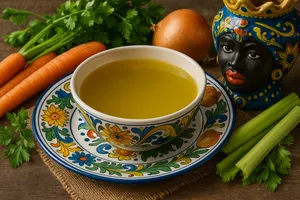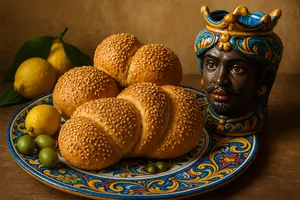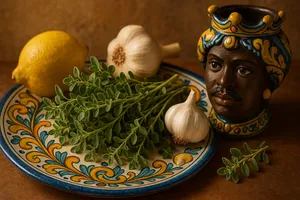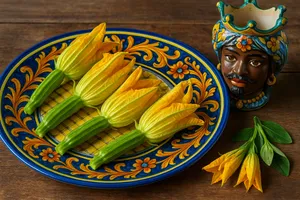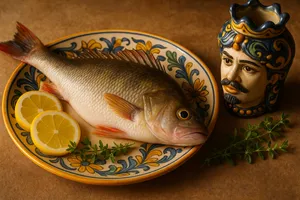Overview
Sage is a perennial aromatic herb of the Lamiaceae family, native to the Mediterranean basin. It features elongated oval leaves with a grey-green colour, velvety surface, and an intense, distinctive aroma—slightly camphor-like and balsamic. In Sicilian cuisine, sage is not as central as in other Italian regions (such as Tuscany or northern Italy), but it is used skillfully in specific dishes where its strong character enhances delicate ingredients or balances richer flavours. Hardy, easy to grow, and productive, sage is a common presence in many Sicilian home gardens.
Traditional Sicilian uses of sage include flavouring meats (especially pork, rabbit, lamb), enriching pasta condiments such as butter and sage, preparing fried sage leaves, and making digestive herbal infusions. Beyond its culinary applications, sage has a long history in herbal medicine: it was traditionally regarded as a plant with many health benefits, used in teas, gargles, and poultices. Its Latin name, salvus (healthy, safe), reflects its ancient reputation as a healing plant. In Sicilian rural culture, sage was highly valued—used both in the kitchen and as a household remedy. Its scent evokes Sunday roasts, traditional kitchens, and the wisdom of grandmothers.
Characteristics
Salvia officinalis has 4–8 cm long, 1–3 cm wide leaves, grey-green or silver-green in colour, covered with fine hairs that give a velvety appearance. The texture is slightly thick and leathery, with smooth or gently serrated edges.
The aroma is intense, aromatic, balsamic, with a characteristic camphor-like note. The flavour is strong, slightly bitter, persistent, with a mildly spicy aftertaste. Young leaves are milder; mature leaves are more pronounced.
The plant forms an evergreen shrub (in mild climates) 30–60 cm high. In spring–summer, it produces purple-blue flowers in spikes, highly decorative and attractive to bees. Fresh leaves are more aromatic, but dried leaves also retain strong flavour (drying concentrates essential oils).
Varieties
Salvia officinalis (common sage)
The most widely used culinary and medicinal variety, with grey-green leaves and a classic intense aroma.
Salvia officinalis ‘Purpurascens’ (purple sage)
A variety with reddish young leaves that mature to green-violet. Similar in flavour to common sage but more ornamental.
Salvia officinalis ‘Tricolor’
A variegated variety with white-pink-green leaves. Decorative and slightly milder in flavour.
Salvia officinalis ‘Icterina’ (golden sage)
Yellow-green variegated leaves, delicate flavour, mainly ornamental.
Salvia sclarea (clary sage)
A different species with larger leaves and a sweet, musky fragrance. Used more in herbalism and perfumery than cooking.
Cultivation
Sage thrives in the Sicilian climate. It prefers full sun, well-drained soil, and tolerates drought well. It does not tolerate waterlogging. It can be propagated by seeds, cuttings, or division.
In Sicilian gardens, sage is a robust perennial requiring little care: occasional watering in extreme summer heat and light pruning after flowering to maintain shape. Plants last for years and produce abundant leaves.
Leaves can be harvested year-round in mild climates. The best time is before flowering in spring, when the leaves are richest in essential oils. Harvest leaves when dry, ideally in the morning after dew has evaporated.
Seasonality
Fresh sage is available year-round in Sicily’s mild climate. Peak quality and production occur in spring and summer.
Use in Sicilian cuisine
Meat seasoning
Sage is used to flavour pork, rabbit, and lamb roasts. Fresh leaves are added to the pot or inserted into the meat during cooking.
Butter and sage
A classic condiment for ravioli, gnocchi, and tortellini. Sage leaves are gently fried in melted butter to create an aromatic sauce. Less traditional in Sicily than in northern Italy, but appreciated.
Fried sage leaves
Whole sage leaves dipped in a light batter and fried until crisp. A delicious appetizer or side dish.
Sauces and ragù
Added sparingly to meat sauces, ragù, and stews to provide a distinctive aromatic note.
Rolls and skewers
Used in meat rolls (such as Messina-style involtini) and skewers, where leaves alternate with meat and pancetta to impart aroma.
Pasta condiments
Sage can be infused in olive oil with garlic to create a simple, flavourful pasta sauce.
Bread and focaccia
Chopped or whole leaves can be incorporated into bread or focaccia dough, or placed on top before baking.
Digestive infusions
Dried or fresh sage leaves are used to make digestive herbal teas after heavy meals.
Fried sage in batter
Traditional recipe:
1. Select large, fresh, intact leaves.
2. Wash and dry thoroughly.
3. Prepare a light batter with flour, sparkling water, and a pinch of salt.
4. Heat abundant oil.
5. Dip leaves in batter and fry until golden.
6. Drain on paper, lightly salt.
7. Serve hot as an appetizer.
Crispy on the outside, soft within, intensely aromatic.
Fresh vs dried sage
Fresh sage: Delicate, bright aroma; ideal for dishes where leaves remain visible. Keeps only a few days in the fridge.
Dried sage: Much stronger due to concentrated essential oils; used in small amounts for sauces and roasts. Keeps for months. Use one-third the amount when substituting for fresh sage.
Storage
Fresh sage should be stored in the refrigerator wrapped in slightly damp paper towel or in a perforated bag for 5–7 days. Wash only before use.
To dry sage: tie sprigs and hang upside down in a dark, ventilated place. After 1–2 weeks, store dried leaves in airtight jars for 6–12 months.
Leaves can also be frozen, though aroma decreases.
Buying tips
Choose vibrant green-grey leaves, firm and unblemished. Avoid yellowing or limp leaves. Aroma should be strong—rub a leaf gently to test.
Buying a potted plant is often the best way to ensure a constant supply of fresh sage.
Herbal uses and properties
Sage contains essential oils (thujone, cineole, camphor), flavonoids, phenolic acids, and tannins. It has antiseptic, anti-inflammatory, antioxidant, digestive, and expectorant properties.
Traditional Sicilian uses include:
Digestive teas after heavy meals.
Gargles for sore throat and oral inflammation.
Poultices for small wounds and insect bites.
Tonic infusions for general well-being.
Note: thujone can be toxic in high doses. Normal culinary use is safe, but strong infusions or prolonged use should be avoided. Not recommended during pregnancy or breastfeeding.
Sage in Mediterranean tradition
Sage has been revered since antiquity. Romans considered it sacred. In the Middle Ages it was used in famous medicinal preparations and grown in monastic gardens.
It has long held a dual identity as both a culinary herb and a medicinal plant.
Curiosities
The Latin proverb Cur moriatur homo cui Salvia crescit in horto? (“Why should a man die when sage grows in his garden?”) illustrates its ancient reputation.
In the language of flowers, sage symbolises wisdom and protection.
Its flowers attract bees and pollinators, supporting biodiversity.
In some Sicilian folk traditions, sage leaves were burned to cleanse and perfume homes.
Sage is one of the few herbs whose aroma intensifies when dried.
Rubbing fresh sage leaves on teeth and gums was an old remedy for oral hygiene.
In cooking, sage pairs exceptionally well with fats (butter, oil, lard), which release and carry its liposoluble aromas.
Sage is a xerophytic plant: its velvety leaves reduce water evaporation, allowing it to thrive in arid Mediterranean climates.


